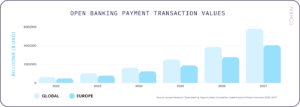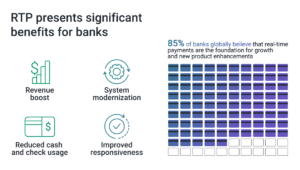
2022 has been a strange year for all. Global events have led to rapidly changing markets, with inflation taking hold across regions and the cost of doing business significantly increasing. While merchants in the UK have seen a decline in sales post-pandemic, international eCommerce has also become unpredictable. 2023 doesn’t look like it will be an easy year either, so it is more important than ever for merchants to optimise their revenue and processes while margins are tight.
With a recession looming, we look at how merchants can identify where opportunities lie in the coming years and how they can optimise their payments now to help them reach a global audience.
The predicted market
To weather the storm in 2023, it is important that merchants can reach every possible consumer that could be interested in their product and service. According to emerchantpay’s Global Payments Outlook report, the eCommerce market has a huge opportunity in the next few years. However, to access the future of eCommerce, merchants need to have a viable business during the recession, when consumer spending is expected to shrink.
Let’s examine what that opportunity is predicted to look like. According to Statista, in Europe, the number of eCommerce users is expected to rise to 564.4 million in three years’ time with user penetration growing from 61.6% in 2022 to 66.5% in 2025, resulting in a projected market volume of US$1,117,178 million. Similarly, APAC is forecast to grow by 10% in 2025, reaching 61% of total retail sales. Further, Statista predicts that the number of eCommerce users is expected to amount to 3,100 million by 2025, with an average revenue per user (ARPU) likely to amount to US$873.53. eCommerce spending in the UAE is expected to increase to more than double over the next few years, going from US$21,107 million in 2021 to US$47,481 million in 2025.
The US has a projected market volume of US$1,529,372 million by 2025. Spending per capita is expected to rise by 46% in 2025 hitting US$6,200 from US$4,242 in 2021. And in Latin America, where mCommerce (mobile commerce) is driving growth revenue is forecasted to almost double in many Latin American countries by 2024, reaching US$96.68 billion in sales.
While this makes for promising reading for the future, getting there in 2023 could prove challenging when it comes to profitability. In regards to payments, it is crucial for merchants to look at where they could experience pitfalls with their payments systems and how they can optimise their payment flows to avoid revenue losses.
Understanding local consumer demands
Wherever they are based, having efficient, seamless, and personalised payments is important for consumers. When targeting consumers cross-border, merchants need to be acutely aware of local nuances so they can offer the efficient, seamless, and preferred payment methods to encourage conversions and consumer trust.
Data is key to understanding both international and domestic consumer trends and preferences. The eCommerce market is seeing rapid change in line with socio-economic factors, but many merchants are still reliant on unoptimised payment systems. With regulations varying and evolving across countries, merchants need innovative payment solutions that will enable them to adapt to local markets and regulatory requirements.
Merchants therefore need to be flexible and offer payment methods and checkout experiences that will enable consumers across the globe to purchase in their payment method and currency of choice. However, while meeting local consumer payment needs, merchants also must ensure their payments strategy is providing them with the most efficient system, to avoid losing revenue due to shortcomings in their payment flows.
Building a strong payment strategy
Merchants who wish to expand internationally will require insights that will enable them to keep up with the changing payment landscape. Understanding the payments market is key to this, so it is important to identify how these insights are obtained. Merchants should look for partners with experience in localised payments, to build a strategy that knows the nuances of each country’s unique regulatory requirements and payment protocols. By harnessing experts with experience in local payments rather than setting up from scratch, merchants will be better placed to quickly reduce the cost of cross-border payments acceptance.
For example, a strong foothold in a particular region will mean they can benefit from more competitive transaction fees for local payment methods, based on the knowledge of which payment methods are popular and what constitutes a good rate for processing.
When choosing a partner, merchants should thoroughly evaluate their cross-border knowledge, as well as do a full audit on their ability to provide innovative technology and payment solutions.
Without being sure of a partner’s full capabilities, merchants run the risk of having to overhaul their operations while still catering for the preferences of customers in other markets. Merchants should consider whether their strategy enables them to accept their target customer’s preferred payment methods, local currency, while providing settlements in the merchant’s preferred currency.
Growing beyond 2023
Having access to the expertise of an experienced payments partner can be a key difference between a merchant’s success and failure for international expansion. For organisations looking to grow in today’s economy, cross-border eCommerce can enable business growth, for example by investing in high-growth markets such as Latin America.
To efficiently establish themselves in new markets, merchants must look to provide a frictionless payment experience to their customers, as well as a simple process for efficiencies around cross-border payments and local acceptance.
- SEO Powered Content & PR Distribution. Get Amplified Today.
- Platoblockchain. Web3 Metaverse Intelligence. Knowledge Amplified. Access Here.
- Source: https://www.finextra.com/blogposting/23425/optimising-international-payments-during-times-of-global-uncertainty?utm_medium=rssfinextra&utm_source=finextrablogs
- 100
- 2021
- 2022
- 2024
- a
- ability
- Accept
- acceptance
- access
- According
- across
- adapt
- All
- america
- American
- amount
- and
- APAC
- around
- audience
- audit
- average
- based
- become
- being
- benefit
- Better
- between
- Beyond
- Billion
- build
- business
- capabilities
- Capita
- challenging
- change
- changing
- Checkout
- choice
- choosing
- coming
- Commerce
- competitive
- Consider
- consumer
- Consumers
- conversions
- Cost
- could
- countries
- country’s
- cross-border
- cross-border payments
- crucial
- Currency
- Customers
- Decline
- difference
- Doesn’t
- doing
- Domestic
- double
- driving
- during
- each
- ecommerce
- economy
- efficiencies
- efficient
- efficiently
- either
- enable
- enables
- encourage
- ensure
- establish
- Europe
- evaluate
- events
- EVER
- evolving
- example
- Expand
- expansion
- expected
- experience
- experienced
- Experiences
- expertise
- experts
- factors
- Failure
- Fees
- few
- Finextra
- flexible
- Flows
- For Consumers
- frictionless
- from
- full
- further
- future
- getting
- Global
- global audience
- Global Payments
- GlobalData
- globe
- going
- good
- Grow
- Growing
- Growth
- Harnessing
- having
- help
- high-growth
- hitting
- hold
- How
- However
- HTTPS
- huge
- identify
- important
- in
- In other
- Increase
- increasing
- inflation
- innovative
- insights
- interested
- International
- International Payments
- internationally
- investing
- IT
- Keep
- Key
- knowledge
- landscape
- Latin
- latin america
- Latin American
- Led
- likely
- Line
- local
- Look
- look like
- looking
- looming
- losing
- losses
- MAKES
- many
- margins
- Market
- Markets
- meeting
- Merchants
- method
- methods
- million
- Mobile
- more
- most
- Need
- needs
- New
- next
- number
- obtained
- offer
- Operations
- opportunities
- Opportunity
- optimise
- Organisations
- Other
- Overhaul
- particular
- partner
- partners
- payment
- payment method
- payment methods
- Payment Systems
- payments
- payments systems
- plato
- Plato Data Intelligence
- PlatoData
- Popular
- possible
- predicted
- preferences
- preferred
- process
- processes
- processing
- Product
- profitability
- projected
- promising
- protocols
- Prove
- provide
- providing
- purchase
- quickly
- rapid
- rapidly
- Rate
- reach
- Reading
- recession
- reduce
- regards
- region
- regions
- regulations
- regulatory
- report
- require
- Requirements
- resulting
- retail
- Retail Sales
- revenue
- Rise
- Risk
- Run
- sales
- seamless
- seeing
- service
- setting
- Settlements
- should
- significantly
- Similarly
- Simple
- So
- Solutions
- Spending
- Still
- Storm
- Strategy
- strong
- success
- such
- system
- Systems
- taking
- Target
- targeting
- Technology
- The
- the UK
- their
- themselves
- therefore
- thoroughly
- three
- time
- times
- to
- today’s
- Total
- transaction
- Transaction Fees
- Trends
- Trust
- UAE
- Uk
- Uncertainty
- understanding
- unique
- unpredictable
- us
- User
- users
- viable
- volume
- Weather
- What
- whether
- which
- while
- WHO
- will
- year
- years
- zephyrnet











